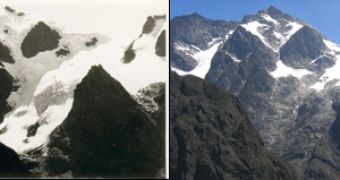Ancient Greeks and Egyptians talked about the Mountains of the Moon as the source of the Nile River. Indeed, the Ruwenzori Mountains, located between Uganda and Democratic Republic of Congo, represent the highest water source for the Nile (with peaks over 16,000 ft (4,900 m)) and one of the few equatorial mountains with an ice cap. But now WWF and National Geographic signals that the mountains have lost 50% of their ice crown in the last 50 years, as revealed by images taken in February 2008.
The cause: global warming or increased humidity. One Ruwenzori glacier is already completely lost. But the loss of ice could menace many species, like leopards and chimpanzees, adapted to the Ruwenzoris' six "microclimates," ranging from forest to heather and icepack. Nearby, the sanctuary of the endangered mountain gorillas of Virunga National Park is located.
The historian Robert Collins wrote about Ruwenzori that it is a mountain in which "elephants wander at 5,000 ft [1,500 m], lions prowl near 8,000 ft [2,400 m], and the leopard is found at 15,000 ft [4,600 m]."
The Ruwenzori glaciers fluctuated from an area of 1,600 acres (650 ha) in 1906 to 870 acres (352 ha) in 1955 to just 366 acres (148 ha) in 2008, as determined by WWF, the Congolese Institute for Nature Conservation, and the Uganda Wildlife Authority.
"At this rate they will be gone in 30 years," said Marc Languy, leader of the ten-day WWF expedition.
Local tourism would be affected too: over 1,200 tourists visited the Ruwenzori glaciers in 2007 in the Ugandan side.
The causes
Global warming is seen as the main culprit. Others point to a natural decrease in humidity that began in the late 1800s.
"I wouldn't rule out that human activity is having an impact on the Ruwenzori," Philip Mote, a research scientist at the University of Washington, told National Geographic News.
"Throughout the tropics, all the glaciers are receding. Whether the cause is decreased humidity or increased temperature, the results are the same. In the Andes precipitation has increased in the last hundred years, but the glaciers are still retreating," Lonnie Thompson, an expert on Andean glaciers at Ohio State University.
Other African mountain glaciers
Other African mountain glaciers will be gone within 25 to 50 years, as revealed by a 2006 research. Deforestation and pollution have already made a big gap on the top glaciers of Mount Kilimanjaro and Mount Kenya.
Kilimanjaro is the highest African mountain (5890 m or 19,630 ft) and Mount Kenya is the second highest mountain in Africa (5199 m or 17,330 ft). Both mountains attract a lot of mountaineers, hikers and tourists. Kilimanjaro has already lost 82 % of its ice cover over 80 years. Mount Kenya lost 92 % of its ice cap in the last century.
These mountains are very important in the hydrological system of Kenya, being the origin for many rivers that are major sources of water and hydrological power.

 14 DAY TRIAL //
14 DAY TRIAL //